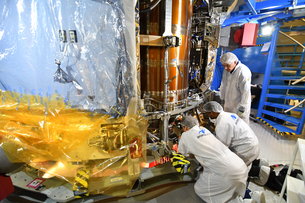19.09.2018
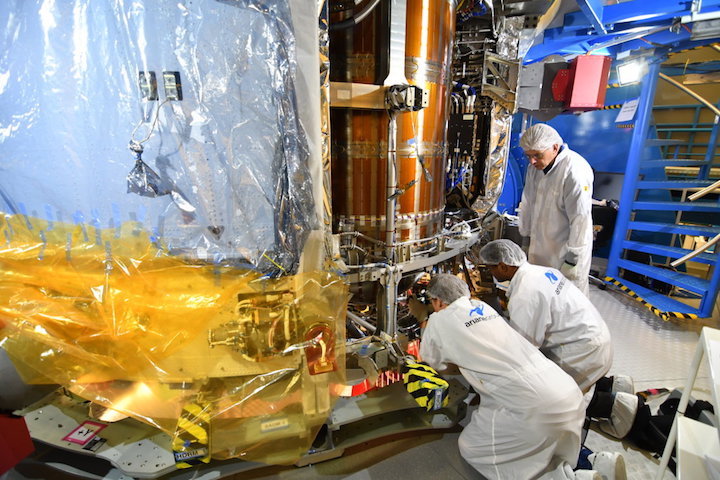
Technicians instal the radiators on the European Service Module for NASA’s Orion spacecraft marking the module’s finished integration.
ESA’s European service module will provide power, water, air and electricity to NASA’s Orion exploration spacecraft that will eventually fly beyond the Moon with astronauts. The European Service Module is now complete for Orion’s first mission that will do a lunar fly-by without astronauts to demonstrate the spacecraft’s capabilities.
Much like closing the bonnet on a car, with the radiators in place technicians can no longer access the internals of the European service module, symbolically ending the assembly and integration of the module that will fly further into our Solar System than any other human-rated spacecraft has ever flown before.
-
ORION’S FIRST SERVICE MODULE INTEGRATION COMPLETE
Last week at the Airbus integration hall in Bremen, Germany, technicians installed the last radiator on the European Service Module for NASA’s Orion spacecraft marking the module’s finished integration.
ESA’s European service module will provide power, water, air and electricity to NASA’s Orion exploration spacecraft that will eventually fly beyond the Moon with astronauts. The European Service Module is now complete for Orion’s first mission that will do a lunar fly-by without astronauts to demonstrate the spacecraft’s capabilities.
Much like closing the bonnet on a car, with the radiators in place technicians can no longer access the internals of the European service module, symbolically ending the assembly and integration of the module that will fly further into our Solar System than any other human-rated spacecraft has ever flown before.
Technicians worked 24 hours a day in three shifts to complete the service module’s assembly which is now going through the last stages of its extensive testing. Engineers will put the module through its paces with functional tests that include checking the newly installed radiators and testing the propulsion system with its intricate pipelines that deliver fuel and oxidiser to the spacecraft’s 33 engines.
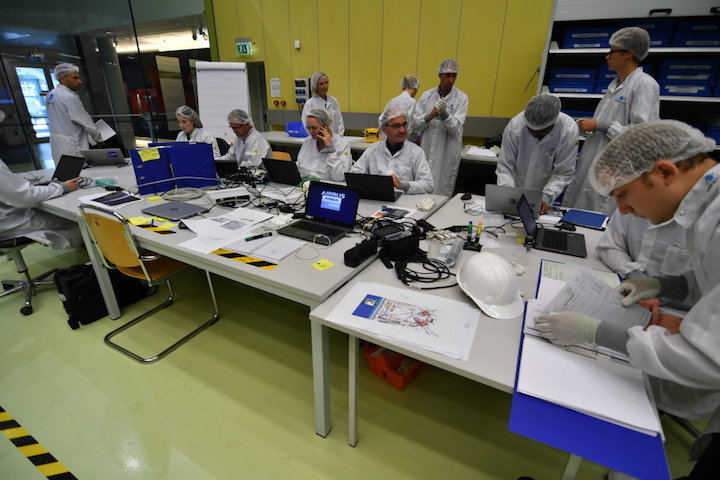
Technicians working on the European Service Module for NASA’s Orion.
ESA’s European service module will provide power, water, air and electricity to NASA’s Orion exploration spacecraft that will eventually fly beyond the Moon with astronauts. The European Service Module is now complete for Orion’s first mission that will do a lunar fly-by without astronauts to demonstrate the spacecraft’s capabilities.
Much like closing the bonnet on a car, with the radiators in place technicians can no longer access the internals of the European service module, symbolically ending the assembly and integration of the module that will fly further into our Solar System than any other human-rated spacecraft has ever flown before.
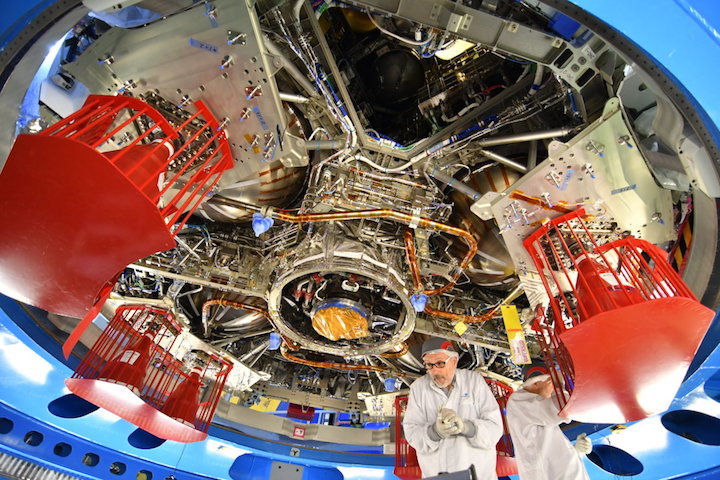
Technicians work underneath the European Service Module for NASA’s Orion spacecraft, September 2018.
ESA’s European service module will provide power, water, air and electricity to NASA’s Orion exploration spacecraft that will eventually fly beyond the Moon with astronauts. The European Service Module is now complete for Orion’s first mission that will do a lunar fly-by without astronauts to demonstrate the spacecraft’s capabilities.
Much like closing the bonnet on a car, with the radiators in place technicians can no longer access the internals of the European service module, symbolically ending the assembly and integration of the module that will fly further into our Solar System than any other human-rated spacecraft has ever flown before.
-
Once complete the service module will be packed and flown to NASA’s Kennedy Space Center in Florida, USA. Orion’s solar wings will be shipped separately, also from Bremen. In the USA the module will be stacked together with NASA’s Crew Module Adaptor and Crew Module, the first time the complete spacecraft will be on display.
More tests await the Orion spacecraft at NASA’s Plum Brook facility where it will be put in the world’s largest vacuum chamber to simulate spaceflight as well as being subjected to acoustic tests to simulate the intense vibrations Orion will endure when launched on the world’s largest rocket, NASA’s Space Launch Systems.
Second module getting ready
Meanwhile technicians in Bremen are not resting as work on the second European Service Module is already well under way. The structure is complete and over 11 km of cables are being meticulously placed in preparation for the computers and equipment that will keep astronauts alive and well for the second Orion mission called Exploration Mission-2.
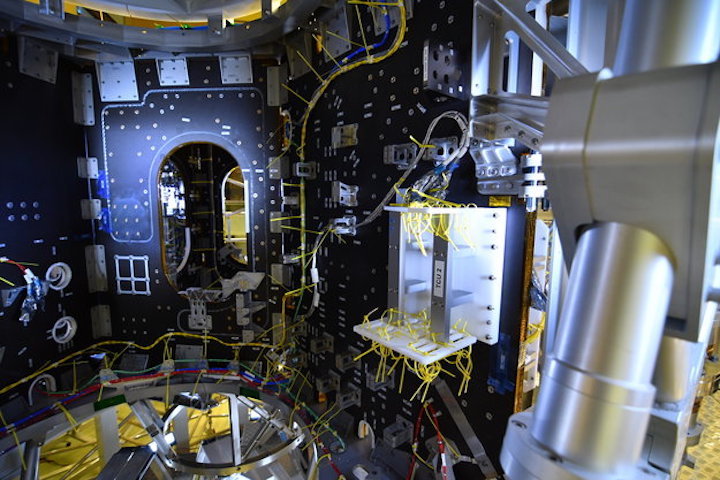
European Service Module-2 wiring at the Airbus integration hall in Bremen, Germany, September 2018.
The structure is complete and over 11 km of cables are being meticulously placed in preparation for the computers and equipment that will keep astronauts alive and well for the second Orion mission called Exploration Mission-2.
Up to four astronauts will fly Orion to 70 000 km beyond the Moon before completing a lunar flyby and returning to Earth. The mission can take a minimum of 8 days and will collect valuable flight test data.
Quelle: ESA
---
Update: 20.09.2018
.
NASA’s Johnson Space Center begins last phase of design work on Orion test module before shipping it to Florida for launch
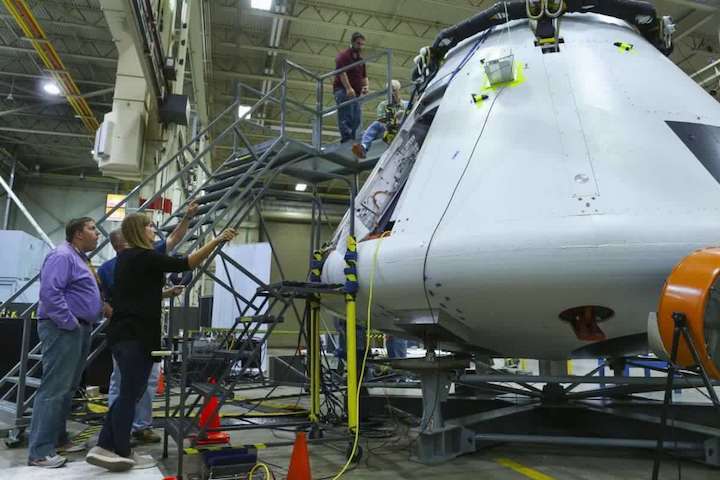
Chasing Orion: This is the fifth in a series of stories leading up to the April 2019 launch of Orion’s launch abort system, which is managed by NASA’s Johnson Space Center in Houston.
When NASA launches the Orion spacecraft to the moon in the coming years, the fate of the four-person crew — for a short while, anyway — depends on four large bolts.
These bolts will automatically explode if the systems detect a problem with the rocket in the seconds after launch, separating the crew module from the boosters so those on board can escape a fiery death.
But before humans strap into the spacecraft, NASA must design and test this escape mechanism (known as the launch abort system) on a mockup module, a simplified version of the real Orion. And this month, personnel at NASA’s Johnson Space Center in Houston are getting ready to install those bolts on this mockup, the next step in their year-long design process leading up to the April 2019 test.
Chasing Orion
In April 2019, NASA will launch a test of the launch abort system for Orion, the spacecraft that will take humans back to the moon for the first time in 50 years. The work on this abort system, which will allow the spacecraft’s eventual four-person crew to escape if the rocket explodes, is being managed by NASA’s Johnson Space Center in Houston.
“We’re just chugging along,” project manager Jon Olansen said.
On that day in April, the mockup capsule will launch from Cape Canaveral, Fla., fulfilling its only purpose before sinking to the bottom of the ocean: testing the primary safety feature for the spacecraft that will take humans back to the moon for the first time in 50 years.
Personnel at the Houston center have been working on the module since March, where they outfitted it with flight computers, communication systems and about 800 data sensors. They also put it through flight simulations, as well as weight and center of gravity testing because it must have the exact same measurements as the real Orion when humans are on board. Earlier this month, the mockup crew module returned to Johnson from NASA’s Ohio-based Glenn Research Center, where it underwent four days of acoustic tests designed to ensure the capsule is structurally sound.
It passed with flying colors, Olansen said, so now the Houston center will attach the crew module to the separation ring — this is where the four large bolts come in — which connects the module to the rocket booster and allows it to separate from the rocket if necessary.
“Those four bolts are the only thing connecting the crew module to the booster,” Olansen said. “When you blow those four bolts, that’s how the crew module separates” from the rest of launch system.
The Orion spacecraft has been in various stages of design for nearly two decades, its destination oscillating between the moon and Mars depending on White House leadership. A return to the moon is a top priority for President Donald Trump’s administration and his $19.9 billion proposed budget for the next fiscal year tasks NASA with launching an unmanned Orion flight by 2021, followed by a launch of Americans around the moon in 2023.
The simplified module will not be reused once the test is complete. Additional capsules for the unmanned and crewed missions are under construction elsewhere. The Space Launch System — the most powerful rocket NASA has ever built that will send Orion to space — as well as the ground systems for launch, also are being developed simultaneously.
From start to finish, the abort system test is expected to account for only $256 million of the program’s more than $11 billion budget, according to NASA.
Johnson personnel also are designing Orion’s cockpit and flight software, spacesuits and parachutes. Just this week, Johnson successfully completed the last parachute test at the U.S. Army’s Yuma Proving Ground in Arizona. Johnson is home to the nation’s astronaut corps, where human space flight research and training take place. It also is home to the International Space Station’s mission operations and the Orion program.
Olansen expects personnel to begin bolting the separation ring to the crew module around Sept. 24, he said, and then it will take about two weeks to link the crew module computer systems to those in the separation ring. Once that’s complete, Johnson personnel will run the capsule and its attachment through a battery of tests to ensure everything is working properly.
It’s the last step before Olansen ships it off to NASA’s Florida-based Kennedy Space Center in November, where it will stay until the launch in April.
“A good portion of the team is going to be at KSC from December until the launch in April,” he said.
Quelle: Houston Chronicle

